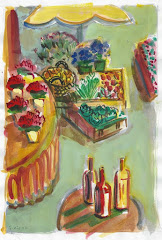Saturday, May 30, 2020
Friday, May 15, 2020
Happiest Critters Alive
I start to listen carefully to the spring skies around the beginning of April. Early April is a bit too early, but better to be tuned in than to miss that first trill trill treep sound sweeping overhead. That’s the sound of the swallows returning. This year I felt like I was waiting forever. Maybe that was because I had more time to linger under the sunny spring skies or maybe there was no noise overriding the promising spring breezes. Finally towards the end of the month I heard it. Trill trill treep They’re back, they’re back! Our swallows were swooping and chattering overhead. Oh the feeling of joy and freedom those small birds carry in on the wing.
I’ve had the good fortune to always live where there have been either swallows or one of their close cousins. It’s a bit hard to distinguish between the four types included in the family. There are subtle differences. Martins glide longer and have a white back and throat. The swallow darts and swoops and has a dark head, red throat and a forked tail. The distinctions don’t really matter because they are all tiny black jets that sweep and dart across the sky chirping that distinctive trill trill treep. They all seem to be the happiest critters alive.
Swallows eat, sleep and mate in flight. They are vulnerable on the ground. Their scientific name is apus apus -(latin for ‘without feet’ ). Their legs are too short and their wings too long to permit them to pick up enough momentum to easily take off from the ground. They don’t take off so much as launch themselves from a perch. The only reasons they have to stop flying is to lay eggs and hatch their chicks.
Originally swallows would have built their nest in rocky cliffs. Humans created more reliable housing with tiled eaves and dry barns to tuck into. Swallows are both faithful to one partner and to one nesting place. They return year after year as long as there is a place to return to…Slowly but surely development and loss of barns are closing up their nesting habitats. There are no specific statistics but their population is declining.
If you have the good fortune to have nesting swallows you will know how spritely and industrious they are. Their nest are small, shallow and bowl shaped, tucked up on a beam or under the eaves. Because they usually nest near other swallows you can’t miss their commotion. Both parents swoop in and out all day long feeding the tiny chicks. When the chicks first hatch you just hear tiny chirps as the parent arrives with a tasty insect. A few days later yellow beaks are peeking over the edge of the nest. Before you know it you can see three to five scrawny necks holding up wobbly heads each clamoring for food each time a parent arrives. If you are patient -or have bad timing- you will see that they are well trained little chicks - they turn around and poop over the edge of the nest. This tidiness is good for the nest, bad for the homeowner. All that gluey poop can be quite a nuisance when the swallows have insisted on nesting over a doorway or where you park your bike. Suddenly one day, usually when you are not looking, the babies perch on the edge of the nest one last time and then there is silence. It’s only been a few weeks and those fledglings are off on the wing. Life’s miracle of babies growing up so fast.
Summer skies are animated by the swallow family. They sweep high when the insects are up and they sweep low skimming along the river when there is an insect hatch. Sometimes I think they swoop high and low just because they can. Trill trill treep. Sometime in August they start to perch on the electric wires. One day you realize the skies have gone quiet, the swallows have left us, autumn is on its way. Thankfully we have a while before that!
Subscribe to:
Posts (Atom)














